Night sky, January 2025: What you can see tonight [maps]
Find out what's up in your night sky during January 2025 and how to see it in this Space.com stargazing guide.
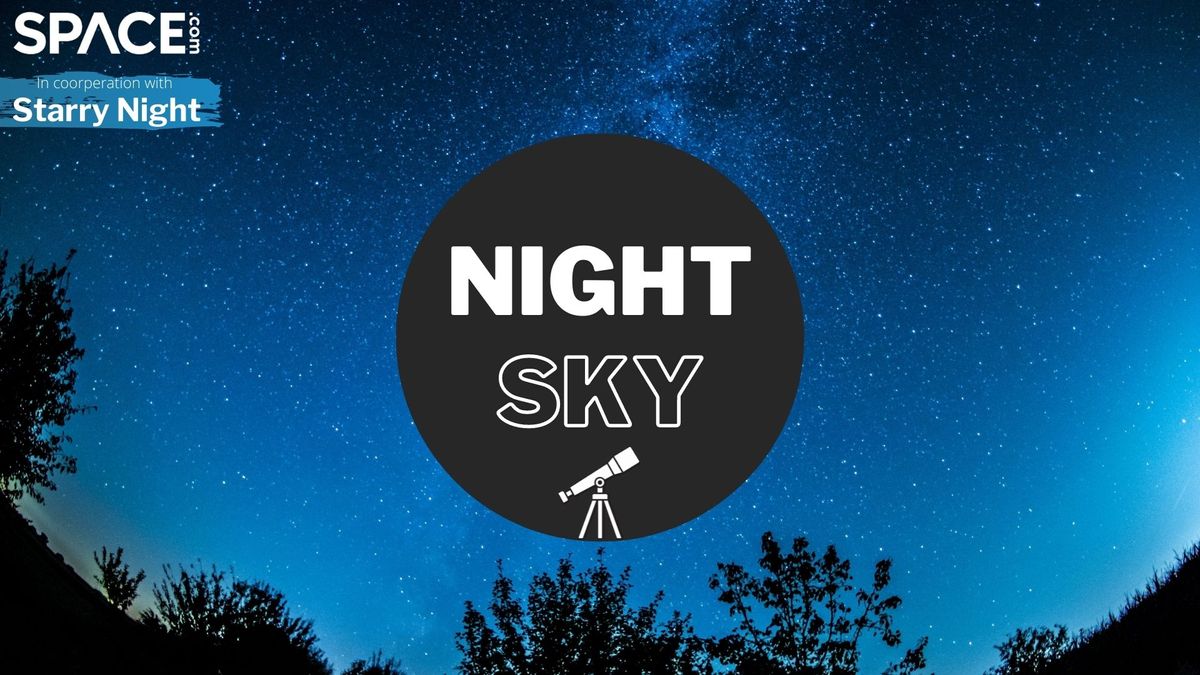
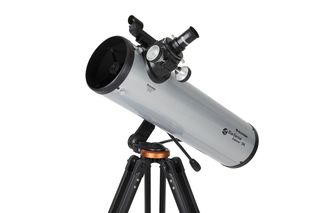
Looking for a telescope for the next night sky event? We recommend the Celestron StarSense Explorer DX 130AZ as the top pick for basic astrophotography in our best beginner's telescope guide.
The night sky tonight and on any clear night offers an ever-changing display of fascinating objects you can see, from stars and constellations to bright planets, the moon, and sometimes special events like meteor showers.
Observing the night sky can be done with no special equipment, although a sky map can be very useful, and a good telescope or binoculars will enhance some experiences and bring some otherwise invisible objects into view. You can also use astronomy accessories to make your observing easier, and use our Satellite Tracker page powered by N2YO.comto find out when and how to see the International Space Station and other satellites. We also have a helpful guide on how you can see and track a Starlink satellite train.
You can also capture the night sky by using any of the best cameras for astrophotography, along with a selection of the best lenses for astrophotography.
Read on to find out what's up in the night sky tonight (planets visible now, moon phases, observing highlights this month) plus other resources (skywatching terms, night sky observing tips and further reading)
Related: The brightest planets in January's night sky: How to see them (and when)
Monthly skywatching information is provided to Space.com by Chris Vaughan of Starry Night Education, the leader in space science curriculum solutions. Follow Starry Night on Twitter @StarryNightEdu and Chris at @Astrogeoguy
Editor's note: If you have an amazing skywatching photo and would like to share them with Space.com's readers, send your photo(s), comments, and your name and location to spacephotos@space.com.
Calendar of observing highlights
Wednesday, Jan. 1 - The Pleiades (all night)
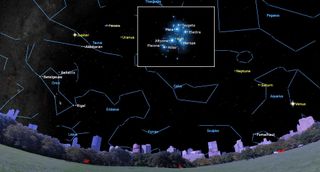
In the evening during early January, the prominent open star cluster known as the Pleiades, the Seven Sisters and Messier 45, is climbing the southeastern sky. The stars of its home constellation Taurus, the Bull, will be below the cluster. This year, the brilliant planet Jupiter will be shining about 1.3 fist diameters to the lower left (or 13 degrees to the celestial east) of the cluster. The “sisters” are medium-bright, hot blue stars named Asterope, Merope, Electra, Maia, Taygeta, Celaeno, and Alcyone.
In Greek mythology, those characters were the daughters of Atlas, and half sisters of the Hyades. They are indeed related – born of the same primordial gas cloud. To the unaided eye, only six of the stars are usually apparent, including their parents Atlas and Pleione huddled together at the east end of the grouping. In binoculars (inset) and backyard telescopes, hundreds of fainter stars surround them. Not surprisingly, many cultures, including Aztec, Maori, Sioux, Hindu, and more, have developed stories about those stars. In Japan, it is called Subaru, and forms the logo of the eponymous car maker. Due to its shape, the cluster is sometimes confused with the Little Dipper.
Thursday, Jan. 2 - The Andromeda Galaxy (all night)
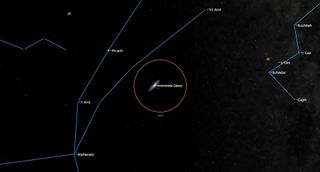
After the sky fully darkens in early January, the Andromeda Galaxy is positioned near the zenith (the highest point in the sky directly above an observer), which is ideal for viewing it through a minimum of Earth's atmosphere. The galaxy will descend the western sky as the hours roll by, but you'll have plenty of time to enjoy it.
This large spiral galaxy, also designated Messier 31 and NGC 224, is 2.5 million light years from us, and covers an area of sky measuring 3 by 1 degrees (or six by two full moon diameters)! Under dark skies, M31 can be seen with unaided eyes as a faint smudge located a palm's width to the lower right (or 7 degrees to the celestial north-northwest) of the medium-bright star Mirach.
The three westernmost stars of W-shaped Cassiopeia, Caph, Shedar, and Navi (Gamma Cas), also conveniently form an arrowhead that points towards M31. Binoculars (orange circle) will reveal the galaxy very well. In a telescope, use your lowest magnification eyepiece and look for M31's two smaller companion galaxies, the foreground, brighter Messier 32 and the more distant, fainter Messier 110.
Friday, Jan. 3 - Crescent Moon Meets Venus (early evening)
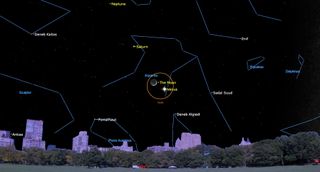
The southwestern sky will provide a beautiful photo opportunity on Friday evening, Jan. 3 when the slender waxing crescent moon will shine near the brilliant planet Venus. They'll be close enough to share the view in binoculars (orange circle) from sunset until they set at about 8:30 p.m. local time.
Keep an eye out for Earthshine on the moon. Sometimes called the Ashen Glow or the Old Moon in the New Moon's Arms, the phenomenon is visible within a day or two of the new moon, when sunlight reflected off Earth and back toward the moon slightly brightens the unlit portion of the moon's Earth-facing hemisphere. A backyard telescope will reveal that Venus has a half-moon shape.
Saturday, Jan. 4 - Earth at Perihelion (at 8 a.m. EST)
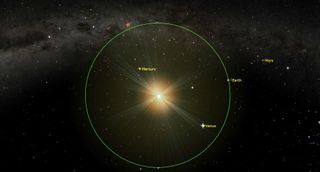
The Earth will reach perihelion, its minimum distance from the sun for the year, on Saturday, Jan. 4 at 8 a.m. EST, or 5 a.m. PST, or 13:00 GMT. At perihelion Earth will be 91.404 million miles (or 147.101 million km) from our star, about 1.67% closer than our mean distance of 1.0 Astronomical Unit.
As winter-chilled Northern Hemisphere dwellers will attest, daily temperatures on Earth are not controlled by our proximity to the sun, but by the number of hours of daylight we experience.
Saturday, Jan. 4 - Waxing Moon joins Saturn (evening)
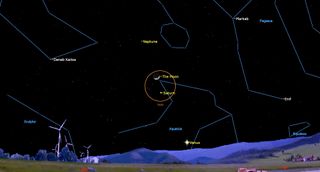
In the southwestern sky after sunset on Saturday, Jan. 4, the yellowish dot of Saturn will appear several finger widths below (or celestial WSW of) the waxing crescent moon — close enough to share the view in binoculars (orange circle).
Venus will gleam to their lower right. The moon and Saturn will be visible from dusk until they set at about 10 p.m. local time. Hours earlier, skywatchers located in a zone extending across northwestern Africa, most of Europe, Iceland, and northeastern Greenland can safely watch the moon occult Saturn with unaided eyes, binoculars, and backyard telescopes. Use an app like Starry Night or Sky Safari to look up the event's start and end times where you live.
Sunday, Jan. 5 - Watch Algol Fade (from 6:42 to 11:42 pm EST)
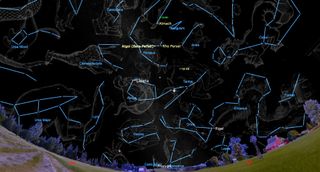
The star Algol in the constellation of Perseus represents the glowing eye of Medusa from Greek mythology. Also designated Beta Persei, it is among the most accessible variable stars for skywatchers. During a ten-hour period that repeats like clockwork every 2 days, 20 hours, and 49 minutes, Algol dims noticeably and re-brightens by about a third when a fainter companion star with an orbit nearly edge-on to Earth crosses in front of its much brighter primary, reducing the total light output we perceive. Algol normally shines at magnitude 2.1, similar to the nearby star Almach (aka Gamma Andromedae).
But while fully dimmed, Algol's brightness of magnitude 3.4 is almost identical to Rho Persei (or Gorgonea Tertia or ρ Per), the star sitting just two finger widths to Algol's lower right (or 2.25 degrees to the celestial south). On Sunday evening, Jan. 5 at 6:42 p.m. EST (or 23:42 GMT), Algol will start to fade from its usual brightness. At that time it will be shining very high in the eastern sky, above and between the bright star Capella and Jupiter.
Five hours later, at 11:42 p.m. EST (or 04:42 GMT on Monday), Algol will have faded to its minimum brightness. It's location at that time will be about halfway up the western sky below Capella and Jupiter. If you miss this attempt, you can watch Algol brighten from its minimum starting at 7:02 p.m. EST on Thursday, Jan. 30.
Monday, Jan. 6 - First Quarter Moon (at 23:56 GMT)
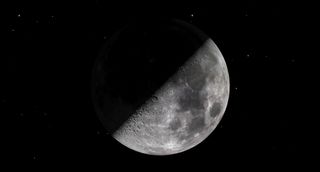
The moon will complete the first quarter of its 29.53-day journey around Earth on Monday, Jan. 6 at 6:56 p.m. EST, or 3:56 p.m. PST, or 23:56 GMT.
At first quarter phase, the moon's 90-degree angle from the sun causes us to see it half-illuminated on its eastern side. First quarter moons always rise around mid-day and set around midnight, so they are also visible in the afternoon daytime sky. The evenings surrounding the first quarter are the best ones for seeing the spectacular lunar terrain when it is lit by low-angled sunlight, especially along the terminator, the pole-to-pole boundary that separates the moon's lit and dark hemispheres.
Tuesday, Jan. 7 - The Goat Star and Her Kids (all night)
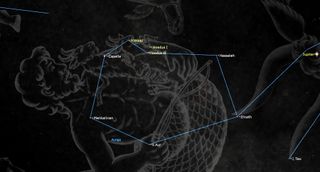
On early January evenings, the constellation of Auriga, the Charioteer is positioned high in the eastern sky. The constellation is dominated by the very bright (magnitude 0.05), yellow, sun-like star Capella, nick-named the Goat Star.
Look several finger widths to the right (or 4 degrees to the celestial south) of Capella for a narrow, sideways triangle of three fainter stars known as the Kids –Almaaz, and Hoedus I, and Hoedus II (or Epsilon, Zeta, and Eta Aurigae). The main stars of Auriga form an ellipse, although the medium-bright star Elnath at its right-hand (or southern) end is actually the northern horn-tip star of Taurus, the Bull.
Wednesday, Jan. 8 - The Stars of Orion's Belt (evening)
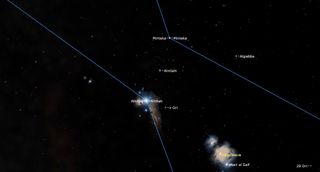
The three stars in Orion's belt may look the same at a glance, but they are actually quite different under closer inspection. Magnitude 1.85 Alnitak (Zeta Orionis) on the left and magnitude 1.65 Alnilam (Epsilon Orionis) in the center shine at almost the same brightness, though Alnilam is almost twice as far away. The magnitude 2.4 star Mintaka (Delta Orionis) on Orion's right hip is quite a bit fainter. Alnitak is blue, while the other two stars are whiter in color.
In a telescope, Alnitak (Arabic for "the Girdle") is revealed to be a very tightly-spaced double star, while Mintaka is a more widely spaced pair. Using binoculars (orange circle) look for a large, upright, S-shaped asterism of dim stars in the space between Alnilam and Mintaka. Sigma Orionis, the medium-bright star shining less than a finger's width to the lower right (or 0.8 degrees southwest of) Alnitak, is a beautiful little grouping of ten or more stars when viewed under magnification
Thursday, Jan. 9 - Moon Crosses the Pleiades (evening)
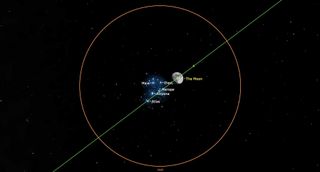
Skywatchers in the Americas on Thursday evening, Jan. 9 can watch the orbital motion of the bright, 82%-illuminated gibbous moon carry it through the Pleiades star cluster (aka Messier 45, Subaru, and the Seven Sisters). In the Eastern Time zone, the event will last from about 7 p.m. to 10:30 p.m. EST (or 00:00 to 03:30 GMT on Friday).
In the Pacific Time zone, the moon will start crossing in a bright sky. While bright moonlight overwhelms fainter objects, viewing the encounter through binoculars (orange circle), will show the "sisters" well. Skywatchers in other parts of the world will see the moon shining close to the cluster.
Friday, Jan. 10 - Venus at Greatest Eastern Elongation (after sunset)
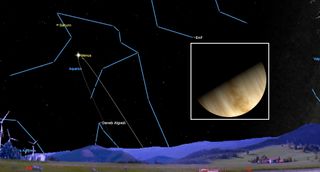
On Friday, Jan. 10, Venus will officially reach its widest separation of 47 degrees east of the sun. Viewed in a telescope (inset), the planet will exhibit a half-illuminated phase.
For best results, observe Venus during evening twilight when the contrast between the bright planet and the surrounding sky is lower. After Friday, our sister planet will continue to brighten and increase in apparent disk diameter as it swings sunward for its inferior solar conjunction in late March.
Friday, Jan. 10 - Bright Moon Joins Jupiter (all night)

At dusk on Friday, Jan. 10, look to the east for the brilliant planet Jupiter shining several finger widths to the lower right (or celestial south) of the bright, waxing gibbous moon — cozy enough to share the view in binoculars (orange circle). The duo will make a lovely photo opportunity when composed with some nice foreground scenery.
As the moon and Jupiter climb higher, the bright stars of winter will appear around them, particularly yellowish Capella on their upper left (celestial north) and reddish Aldebaran to their right (celestial south). Both stars are part of the huge winter hexagon asterism. The moon and Jupiter will culminate due south around 9:30 p.m. local time and set in the west before dawn on Saturday morning. By then the diurnal rotation of the sky will lift the moon above Jupiter.
Saturday, Jan. 11 - Mars Closest to Earth (overnight)
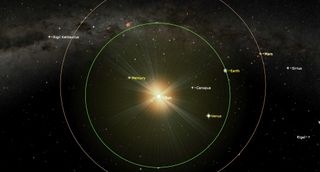
A few days before Mars reaches opposition on Jan. 15-16, the red planet will be closest to Earth on Saturday, Jan. 11 in the Americas. That night, Mars will be 59.70 million miles, 96.08 million km, or 5.33 light-minutes away. You can view the bright reddish planet from late evening onward, near the bright stars Pollux and Castor in Gemini.
In a telescope, the planet will exhibit its maximum apparent disk size of 14.6 arc-seconds, revealing the greatest amount of surface detail this year. Mars will continue to brighten in the sky until opposition night. The difference in the two dates arises because the distance between Earth's and Mars' elliptical orbits is increasing at this time of the year.
Sunday, Jan. 12 - Full Moon in the Winter Football (evening)
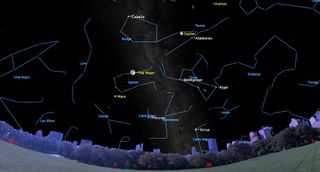
From Friday until Sunday night, Jan. 12, the nearly full moon will shine inside the Winter Football asterism, also known as the Winter Hexagon and Winter Circle. The asterism is composed of the brightest stars in the constellations of Canis Major, Orion, Taurus, Auriga, Gemini, and Canis Minor — specifically Sirius, Rigel, Aldebaran, Capella, Castor & Pollux, and Procyon.
Once Sirius has risen above the rooftops in the southeast around 7 p.m. local time, the huge pattern will straddle nearly 70 degrees of the southeastern sky. In late evening, the asterism will stand upright in the southern sky, with the Milky Way ascending vertically through it. The hexagon is visible during the evening from mid-November to spring every year. Jupiter, which is brighter than any of the asterism's stars, will be spending this month on the western rim of the football, between Aldebaran and Capella.
Monday, Jan. 13 - Full Wolf Moon with Mars (at 22:27 GMT)
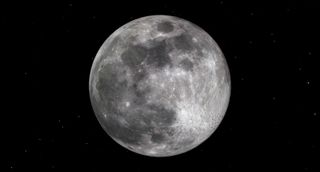
The January full moon, which always shines in or near the stars of Gemini or Cancer, will occur on Monday, Jan. 13 at 5:27 p.m. EST, 2:27 a.m. PST, or 22:27 GMT. At that time, the bright red planet Mars will be shining just to the moon's lower left (or celestial east). This full moon is known as the Wolf Moon, Old Moon, and Moon after Yule.
The Indigenous Ojibwe people of the Great Lakes region call it Gichi-manidoo Giizis, the "Great Spirit Moon", a time to honor the silence, and recognize one's place within all of Great Mystery's creatures. (You might recall that name from hearing or singing Henry Wadsworth Longfellow's The Song of Hiawatha.) The Cree of North America call the January full moon Opawahcikanasis, the "Frost Exploding Moon", when trees crackle from the extreme cold temperatures.
Full moons during the winter months climb as high in the sky as the summer noonday sun, and cast shadows in the same locations. Bright ray systems radiating from the youngest large craters are prominent around the full moon.
Monday, Jan. 13 - Full Moon Occults Mars (10 p.m. EST)
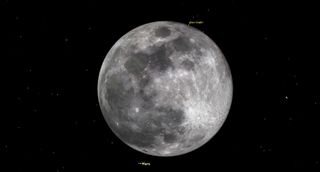
On Monday evening, Jan. 13, observers across the continental USA, northern Mexico, south and eastern Canada, and northwestern Africa will be treated to the full moon passing in front of, or occulting, Mars. The event can be observed with unaided eyes, binoculars, and any backyard telescope.
The start and end times vary by location, so use an app like Starry Night or Sky Safari to determine your own circumstances. In New York City, the leading edge of the moon will cover Mars at 9:21 p.m. EST. Mars will reappear from behind Mare Smythii on the moon's opposite limb at 10:37 p.m. EST. In Africa, the occultation will occur before dawn on Tuesday morning. Lunar occultations are safe to observe without filters. Start watching several minutes ahead of your scheduled occultation times.
Wednesday, Jan. 15 - Mars at Opposition (all night)
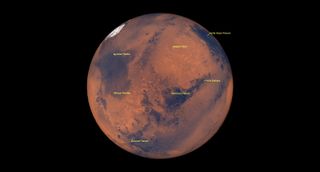
Mars will officially reach opposition at 10 p.m. EST on Wednesday, Jan. 15. On that night, the bright red planet will rise with the stars of Gemini at sunset, climb to its highest position due south around midnight local time, and then set at sunrise.
The bright, recently full moon will rise two hours after Mars and follow it across the sky. On opposition night, Mars will shine with a peak visual magnitude of -1.38. Although its distance from Earth of 59.83 million miles, 96.29 million km, 0.644 AU, or 5.35 light-minutes will be slightly farther than it was at closest approach on Jan. 11, Mars will still be an impressive sight in backyard telescopes for some time, showing an apparent disk diameter of 14.55 arc-seconds. (In comparison, Jupiter's disk spans about 42 arc-seconds.)
Mars' Earth-facing hemisphere on Jan. 15 will display its bright northern polar cap — visible as a small bright spot along the planet's edge, as well as the dark Aurorae Planum, Acidalia Planitia, Meridiani Planum, Terra Sabaea, Syrtis Major Planitia regions, and the lighter-toned Chryse Planitia and Arabia Terra regions. Mars oppositions occur approximately every 25.5 months.
Saturday, Jan. 18 - Venus Kisses Saturn (evening)
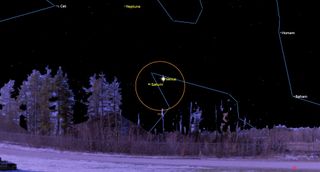
After several months of courtship, the motion of the bright planet Venus will pass only a generous thumb's width (or 2 degrees) from 200 times fainter Saturn on Saturday evening, Jan. 18. The duo will be close enough to share the view in binoculars and backyard telescopes (orange circle) using a low magnification eyepiece.
Try to view the conjunction after dusk, as the planets will be dropping into the trees around 8 p.m. local time. If Saturday is cloudy, you can see them a bit more widely separated on the surrounding nights.
Tuesday, Jan. 21 - Crescent Moon nears Spica (wee hours to sunrise)
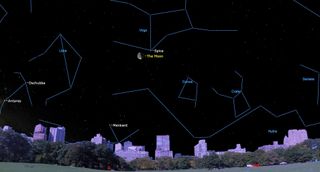
Early risers on Tuesday morning, Jan. 21 can see the pretty, waning crescent moon shining in the southeastern sky just below (or celestial east of) the brightest star in the Virgo constellation, Spica. If you view the pair at sunrise, or in westerly time zones, the moon will be farther from the star. Observers in a zone covering the South Atlantic Ocean, the Cape Verde Islands, and parts of western and southern Africa can watch the moon occult Spica in the wee hours of Tuesday morning.
The event can be observed with unaided eyes, binoculars, and any backyard telescope. The start and end times vary by location, so use an app like Starry Night or Sky Safari to determine your own circumstances
Tuesday, Jan. 21 - Third Quarter Moon (at 20:31 GMT)

The moon will complete three quarters of its orbit around Earth, measured from the previous new moon, on Tuesday, Jan. 21 at 3:31 p.m. EST or 12:31 p.m. PST, or 20:31 GMT. At the third (or last) quarter phase the moon appears half-illuminated, on its western, sunward side.
It will rise around midnight local time, and then remain visible until it sets in the western daytime sky in early afternoon. Third quarter moons are positioned ahead of the Earth in our trip around the Sun. About 3.5 hours later, Earth will occupy that same location in space. The week of dark, moonless evening skies that follow this phase are ideal for observing fainter deep sky targets.
Wednesday, Jan. 22 - Mars Close to Pollux (all night)
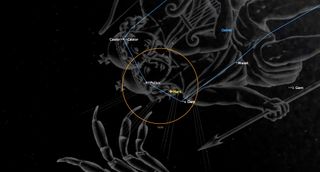
From mid-January to mid-April Mars' retrograde loop will carry it through the stars of Gemini. On Wednesday, Jan. 22, the bright red planet will pass only 2.4 degrees from Gemini's bright, white star, Pollux. The planet and the star will be less than two finger widths apart for several days, and binoculars close (orange circle) for several weeks.
After dusk the pair will be located low in the eastern sky. They'll climb high, due south, by midnight and set in the west just before sunrise. After Wednesday, Mars will continue to travel into central Gemini.
Friday, Jan. 24 - Moon Attacks the Scorpion (pre-dawn)
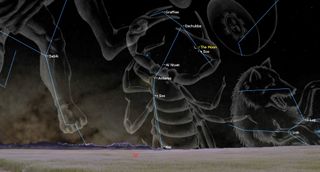
In the southeastern sky before dawn on Friday morning, Jan. 24, the waning crescent moon will be shining among the medium-bright stars that form the claws of Scorpius, barely missing an occultation of the southernmost star, Pi Scorpii. The moon's easterly orbital motion (by about its own diameter every hour) will produce an occultation of Scorpius' brightest star Antares on Saturday morning for observers located in the Indian Ocean east of Madagascar, including Mauritius and Reunion Islands.
Saturday, Jan. 25 - The Spectacular Orion Nebula (all night)
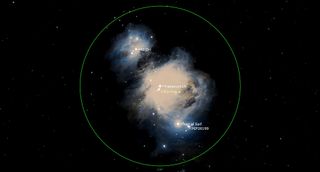
The bright stars of mighty Orion, the Hunter, shine in the southeastern sky during evenings in January. Orion's sword, which covers an area of 1.5 by 1 degrees (about the end of your thumb held up at arm's length), descends from Orion's three-starred belt.
The patch of light in the middle of the sword is the spectacular and bright nebula known as the Orion Nebula (or Messier 42 and NGC 1976). While binoculars will reveal the fuzzy nature of this object, medium-to-large aperture backyard telescopes (green circle) will show complex veils of gas and dark dust lanes, and the Trapezium Cluster, a tight clump of young stars that formed from the nebula's collapsing gas. The nebula and its internal stars are located approximately 1,350 light-years from the sun in the Orion arm of our Milky Way galaxy.
Wednesday, Jan. 29 - New Moon (at 12:36 GMT)
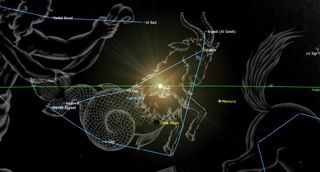
The moon will reach its new phase on Wednesday, Jan. 29 at 7:36 a.m. EST, 4:36 a.m. PST, or 12:36 GMT. At that time our natural satellite will be located in Capricornus and 4.6 degrees south of the sun. While new, the moon is travelling between Earth and the sun. Since sunlight can only reach the far side of the moon, and the moon is in the same region of the sky as the sun, the moon becomes unobservable from anywhere on Earth for about a day (except during a solar eclipse). On the evenings following the new moon phase, Earth's planetary partner will return to shine in the western sky after sunset.
Thursday, Jan. 30 - Uranus Stands Still (evening)
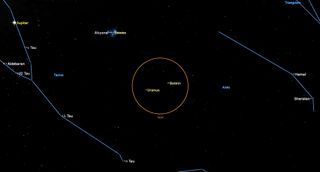
On Thursday, Jan. 30, the motion of the distant, blue-green planet Uranus through the background stars of eastern Aries will slow to a stop - completing a westward retrograde loop that it began in early September. After tonight, the planet will begin to creep eastward again.
At magnitude +5.7, Uranus can be seen in binoculars and backyard telescopes, and even with unaided eyes under dark skies. In mid-evening, the planet's small, blue-green dot will be shining less than a fist's diameter to the lower right (or 8 degrees to the celestial southwest) of the bright Pleiades star cluster, Messier 45. Place the medium-bright star Botein (Delta Arietis) in the upper right part of your binoculars field of view (orange circle) and Uranus will be the dull blue "star" positioned about half the field to Botein's lower left. Once you have identified Uranus, enlarge the planet with your telescope.
Friday, Jan. 31 - Crescent Moon Shines with Saturn and Venus (early evening)
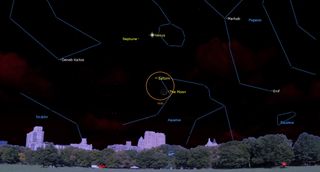
The western sky on Friday, Jan. 31 after sunset will offer a pretty sight and photo opportunity when the slim crescent of the waxing moon will shine below Saturn, with much brighter Venus gleaming above them. The moon and Saturn will be close enough to share the view in binoculars (orange circle).
Hours later, observers in northeastern Russia can see the moon occult Saturn for the second time in January, at about midnight local time.
Visible planets in January
Mercury
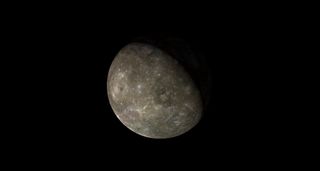
As January begins, Mercury will shine above the southeastern horizon before sunrise while it completes its best morning apparition of the year for mid-northern latitude observers. The bright star Antares will shine more than a fist’s diameter to Mercury’s right. Recently past its greatest elongation, the planet will increase a little in brightness while it drops sunward every morning, but it will become difficult to see against the bright sky after mid-month.
In early January, Mercury will rise at around 6 a.m. local time, making the best time to see it about half an hour later. If you view Mercury in a telescope this month (only before the sun begins to rise), Mercury’s increasing distance from Earth will reduce its apparent disk size from 5.8 to 4.8 arc-seconds, while its illuminated phase will increase from 78% to 98%.
Venus
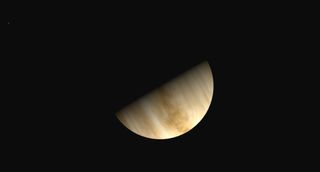
Venus will continue to dominate the southwestern early evening sky during January, brightening from magnitude -4.46 to -4.76 over the month. On Jan. 1, the brilliant planet will appear even before sunset and set around 8:30 p.m. local time. It will reach its greatest elongation, 47 degrees east of the sun, on January 10, and then begin a slow return sunward.
Meanwhile, the planet will be carried higher in the sky each night as the ecliptic tilts more vertically. At the end of January, Venus will set by 9 p.m. local time.
After commencing January among the stars of eastern Aquarius, Venus will travel steadily eastward towards Saturn, passing very close to the star Hydor on Jan. 14 and then pairing with Saturn in a very close conjunction on Jan. 18. Venus will continue on into Pisces on Jan. 23. Telescope views of Venus in January will show a gradually waning, half-illuminated phase on a disk that grows in apparent diameter from 22.2 to 31.9 arc-seconds. The waxing crescent moon will shine just to the upper left (or celestial east of) Venus on Jan. 3.
Mars

With its opposition night fast approaching, Mars will begin January by rising shortly after sunset. It will follow much brighter Jupiter across the sky all night long and shine low in the western sky at sunrise. On Jan. 1, Mars will be within Cancer, about a palm’s width above (or 6 degrees to the celestial northwest of) the prominent Beehive Cluster, or Messier 44. The planet’s westward retrograde motion will take it into Gemini on Jan. 12 and just south of Gemini’s bright star Pollux on January 21. In the wee hours of Jan. 12 in the Americas, Mars will be closest to Earth – at a distance of 59.70 million miles, 96.08 million km, or 5.33 light-minutes. That will be the best night to view the markings on Mars' 14.6 arc-seconds-wide globe, especially the bright northern polar cap and the dark Acidalia Planitia region.
The Martian moons Phobos and Deimos are more readily seen around closest approach, too – especially when they venture farthest from Mars’ glare. On January 13, observers across the continental USA, northern Mexico, south and eastern Canada, and northwestern Africa can watch the full moon occult Mars. The event can be observed with unaided eyes, binoculars, and any backyard telescope. The start and end times vary by location, so use an app like Starry Night or Sky Safari to determine your own circumstances. In New York City, the leading edge of the moon will cover Mars at 9:21 p.m. EST. Mars will reappear from behind Mare Smythii on the moon’s opposite limb at 10:37 p.m. EST. In Africa, the occultation will occur before dawn on Tuesday morning. Because Mars’ elliptical orbit is veering wider from Earth’s during January, Mars’ opposition won’t occur until 10 p.m. on Jan. 15 in the Americas.
On opposition night, Mars will shine with a peak visual magnitude of -1.38. Although its distance from Earth of 59.83 million miles, 96.29 million km, 0.644 AU, or 5.35 light-minutes will be slightly farther than it was at closest approach, Mars will still be an impressive sight in backyard telescopes for some time, showing an apparent disk diameter of 14.55 arc-seconds. Mars' Earth-facing hemisphere on Jan. 15 will display its bright northern polar cap as well as the dark Aurorae Planum, Acidalia Planitia, Meridiani Planum, Terra Sabaea, Syrtis Major Planitia regions, and the lighter-toned Chryse Planitia and Arabia Terra regions. Mars oppositions occur approximately every 25.5 months. As Mars increases its distance from Earth after opposition, it will fade a bit to magnitude -1.06 at the end of January.
Jupiter
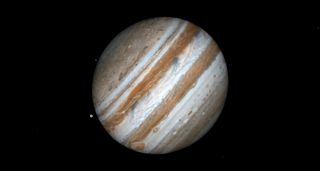
The extremely bright, white planet Jupiter will be well-placed for observing all night long during January. The gas giant will be climbing the eastern sky during the evening while it treks westward between the horns of Taurus - to the left (or celestial northeast) of Taurus' bright, reddish star Aldebaran.
Visually, Jupiter will decrease a little in brightness from its Jan. 1 magnitude of -2.73. Binoculars will reveal Jupiter’s four large Galilean moons flanking the planet. A backyard telescope will show its equatorial bands on a disk that will decrease from 46.95 to 43.4 arc-seconds across, while a better quality instrument will reveal the Great Red Spot every 2nd or 3rd night, Jupiter's Galilean satellites frequently eclipsing and occulting one another, and times when they cast their round, black shadows on the planet. The waxing gibbous moon will shine to the upper left (celestial north) of Jupiter on Jan. 10.
Saturn
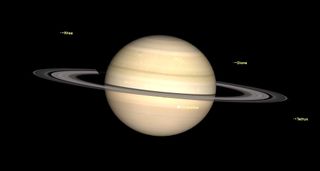
The month of January will bring to a close a lengthy period of telescope viewing of Saturn. The planet will begin the month in the western sky shining at magnitude 1.1 among the stars of Aquarius and setting shortly before 10 p.m. local time. At month’s end, the ringed planet will be too low for clear telescope views once it emerges from the twilight after dusk, but it will continue to be visible to unaided eyes and binoculars until it sets around 8 p.m. local time.
Viewed in a telescope, Saturn will show an apparent disk diameter of about 16.3 arc-seconds and the rings will subtend 38 arc-seconds. The rings, which will become more and more edge-on to Earth until late March, 2025, will appear as a line drawn through the planet’s equator. Saturn’s moons will travel near the ring plane this year, allowing you to see the transits of them and their tiny black shadows across Saturn’s globe – sometimes in pairs – through high-quality telescopes.
The waxing crescent moon will shine several degrees to the upper left (or celestial east) of Saturn on Jan. 3. Hours earlier, observers located in a zone extending across northwestern Africa, most of Europe, Iceland, and northeastern Greenland can watch the moon occult Saturn. After several months of approach, the motion of the bright planet Venus will pass just 2 degrees north of 200 times fainter Saturn on Jan. 18, producing a lovely conjunction.
Uranus
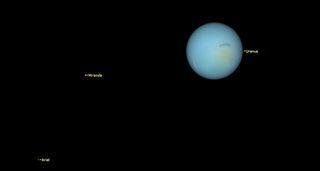
During January, Uranus will be observable from dusk to beyond midnight as it leads far brighter Jupiter across the sky. Visible in a backyard telescope or binoculars on moonless nights, its small, blue-green, magnitude 5.7 dot will be moving slowly retrograde westwards in eastern Aries, about 8 degrees to the lower right (or celestial southwest) of the bright Pleiades Cluster. That motion will cease on Jan. 30 when Uranus returns to prograde motion.
On Jan. 8 and 9 the bright, waxing gibbous moon will shine a palm’s width to the upper right (or celestial west) and upper left (celestial northeast) of Uranus, respectively.
Neptune
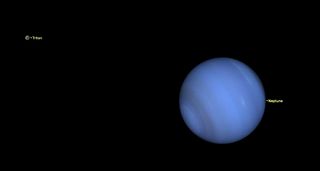
During January, the distant planet Neptune will be observable on moonless evenings as a blue, magnitude 7.9 speck positioned just above (or celestial north of) the medium-bright stars 20 and 24 Piscium that shine near the Pisces-Aquarius border in the western sky.
Much brighter Saturn will be shining about 11 degrees to Neptune's lower right (or celestial west) all month long. Venus will race past Saturn and pass only 3 degrees to the right of Neptune on Jan. 31. Neptune will be easiest to see while it is highest in the sky immediately after the sky fully darkens. In a telescope, its tiny disk will span 2.2 arc-seconds. Larger telescopes can also show Neptune's large moon Triton.
Skywatching terms
Gibbous: Used to describe a planet or moon that is more than 50% illuminated.
Asterism: A noteworthy or striking pattern of stars within a larger constellation.
Degrees (measuring the sky): The sky is 360 degrees all the way around, which means roughly 180 degrees from horizon to horizon. It's easy to measure distances between objects: Your fist on an outstretched arm covers about 10 degrees of sky, while a finger covers about one degree.
Visual Magnitude: This is the astronomer's scale for measuring the brightness of objects in the sky. The dimmest object visible in the night sky under perfectly dark conditions is about magnitude 6.5. Brighter stars are magnitude 2 or 1. The brightest objects get negative numbers. Venus can be as bright as magnitude minus 4.9. The full moon is minus 12.7 and the sun is minus 26.8.
Terminator: The boundary on the moon between sunlight and shadow.
Zenith: The point in the sky directly overhead.
Night sky observing tips
Adjust to the dark: If you wish to observe fainter objects, such as meteors, dim stars, nebulas, and galaxies, give your eyes at least 15 minutes to adjust to the darkness. Avoid looking at your phone's bright screen by keeping it tucked away. If you must use it, set the brightness to minimum — or cover it with clingy red film.
Light Pollution: Even from a big city, one can see the moon, a handful of bright stars, and the brightest planets - if they are above the horizon. But to fully enjoy the heavens — especially a meteor shower, the fainter constellations, or to see the amazing swath across the sky that is the disk of our home galaxy, the Milky Way — rural areas are best for night sky viewing. If you're stuck in a city or suburban area, use a tree or dark building to block ambient light (or moonlight) and help reveal fainter sky objects. If you're in the suburbs, simply turning off outdoor lights can help.
Prepare for skywatching: If you plan to be outside for more than a few minutes, and it's not a warm summer evening, dress more warmly than you think is necessary. An hour of winter observing can chill you to the bone. For meteor showers, a blanket or lounge chair will prove to be much more comfortable than standing, or sitting in a chair and craning your neck to see overhead.
Daytime skywatching: On the days surrounding first quarter, the moon is visible in the afternoon daytime sky. At last quarter, the moon rises before sunrise and lingers into the morning daytime sky. When Venus is at a significant angle away from the sun it can often be spotted during the day as a brilliant point of light - but you'll need to consult an astronomy app to know when and where to look for it. When large sunspots develop on the sun, they can be seen without a telescope — as long as you use proper solar filters, such as eclipse glasses. Permanent eye damage can occur if you look at the sun for any length of time without protective eyewear.
Join our Space Forums to keep talking space on the latest missions, night sky and more! And if you have a news tip, correction or comment, let us know at: community@space.com.
Get the Space.com Newsletter
Breaking space news, the latest updates on rocket launches, skywatching events and more!
Chris Vaughan, aka @astrogeoguy, is an award-winning astronomer and Earth scientist with Astrogeo.ca, based near Toronto, Canada. He is a member of the Royal Astronomical Society of Canada and hosts their Insider's Guide to the Galaxy webcasts on YouTube. An avid visual astronomer, Chris operates the historic 74˝ telescope at the David Dunlap Observatory. He frequently organizes local star parties and solar astronomy sessions, and regularly delivers presentations about astronomy and Earth and planetary science, to students and the public in his Digital Starlab portable planetarium. His weekly Astronomy Skylights blog at www.AstroGeo.ca is enjoyed by readers worldwide. He is a regular contributor to SkyNews magazine, writes the monthly Night Sky Calendar for Space.com in cooperation with Simulation Curriculum, the creators of Starry Night and SkySafari, and content for several popular astronomy apps. His book "110 Things to See with a Telescope", was released in 2021.
-
Malcolm Hi MMohammad,Reply
Thank you for your gracious welcome via email, though I fear we are ‘light years’ away from each other (as my comment shows, if it stays and is not censored) when it comes to this Earth and the Universe in which we live. I am no expert but each to their own beliefs.
Regards,
Malcolm -
Skyguy712 Reply
so much cap like if they don't exist then it's all most impossible for the universe to exist, i have a theory of the big bang, the white hole theory, i believe that a black hole had held gas and dust for millions of years and then it got older and older that it had died and spit up the dust and matter and gas and such, then it all collided making planets and suchcorey555 said:Black holes don't exist -
bwana4swahili So why the "Night sky, October 2021: What you can see this month" title in the newsletter. Have I been transported back to 2021??Reply -
COLGeek Reply
Corrected. Thank you.bwana4swahili said:So why the "Night sky, October 2021: What you can see this month" title in the newsletter. Have I been transported back to 2021??
